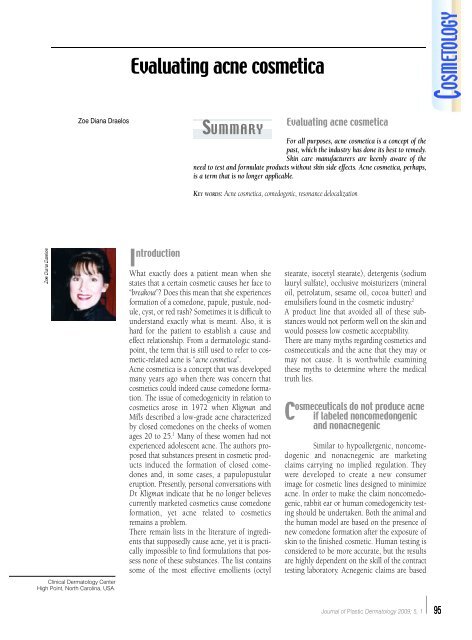Vol. 5, n. 1, January-March 2009 1th International ... - Salute per tutti
Vol. 5, n. 1, January-March 2009 1th International ... - Salute per tutti
Vol. 5, n. 1, January-March 2009 1th International ... - Salute per tutti
Create successful ePaper yourself
Turn your PDF publications into a flip-book with our unique Google optimized e-Paper software.
Zoe Diana Draelos<br />
Clinical Dermatology Center<br />
High Point, North Carolina, USA.<br />
Evaluating acne cosmetica<br />
SU M M A R Y<br />
I ntroduction<br />
What exactly does a patient mean when she<br />
states that a certain cosmetic causes her face to<br />
“breakout”? Does this mean that she ex<strong>per</strong>iences<br />
formation of a comedone, papule, pustule, nodule,<br />
cyst, or red rash? Sometimes it is difficult to<br />
understand exactly what is meant. Also, it is<br />
hard for the patient to establish a cause and<br />
effect relationship. From a dermatologic standpoint,<br />
the term that is still used to refer to cosmetic-related<br />
acne is “acne cosmetica”.<br />
Acne cosmetica is a concept that was developed<br />
many years ago when there was concern that<br />
cosmetics could indeed cause comedone formation.<br />
The issue of comedogenicity in relation to<br />
cosmetics arose in 1972 when Kligman and<br />
Mills described a low-grade acne characterized<br />
by closed comedones on the cheeks of women<br />
ages 20 to 25. 1 Many of these women had not<br />
ex<strong>per</strong>ienced adolescent acne. The authors proposed<br />
that substances present in cosmetic products<br />
induced the formation of closed comedones<br />
and, in some cases, a papulopustular<br />
eruption. Presently, <strong>per</strong>sonal conversations with<br />
Dr. Kligman indicate that he no longer believes<br />
currently marketed cosmetics cause comedone<br />
formation, yet acne related to cosmetics<br />
remains a problem.<br />
There remain lists in the literature of ingredients<br />
that supposedly cause acne, yet it is practically<br />
impossible to find formulations that possess<br />
none of these substances. The list contains<br />
some of the most effective emollients (octyl<br />
Evaluating acne cosmetica<br />
For all purposes, acne cosmetica is a concept of the<br />
past, which the industry has done its best to re m e d y.<br />
Skin care manufacturers are keenly aware of the<br />
need to test and formulate products without skin side effects. Acne cosmetica, <strong>per</strong>h a p s ,<br />
is a term that is no longer applicable.<br />
KE Y W O R D S: Acne cosmetica, comedogenic, resonance delocalization<br />
stearate, isocetyl stearate), detergents (sodium<br />
lauryl sulfate), occlusive moisturizers (mineral<br />
oil, petrolatum, sesame oil, cocoa butter) and<br />
emulsifiers found in the cosmetic industry. 2<br />
A product line that avoided all of these substances<br />
would not <strong>per</strong>form well on the skin and<br />
would possess low cosmetic acceptability.<br />
There are many myths regarding cosmetics and<br />
cosmeceuticals and the acne that they may or<br />
may not cause. It is worthwhile examining<br />
these myths to determine where the medical<br />
truth lies.<br />
osmeceuticals do not produce acne<br />
C if labeled noncomedongenic<br />
and nonacnegenic<br />
Similar to hypoallergenic, noncomedogenic<br />
and nonacnegenic are marketing<br />
claims carrying no implied regulation. They<br />
were developed to create a new consumer<br />
image for cosmetic lines designed to minimize<br />
acne. In order to make the claim noncomedogenic,<br />
rabbit ear or human comedogenicity testing<br />
should be undertaken. Both the animal and<br />
the human model are based on the presence of<br />
new comedone formation after the exposure of<br />
skin to the finished cosmetic. Human testing is<br />
considered to be more accurate, but the results<br />
are highly dependent on the skill of the contract<br />
testing laboratory. Acnegenic claims are based<br />
Journal of Plastic Dermatology <strong>2009</strong>; 5, 1 95

















